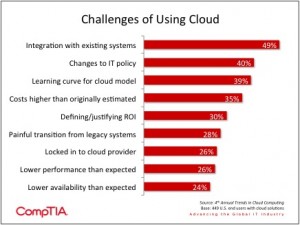It seems a majority of companies are adopting Cloud Computing as a significant portion of their IT infrastructure. According the Computing Technology Industry Association (CompTIA) 4th Annual Trends in Cloud Computing, sixty percent of companies surveyed, reported they rely on Cloud Computing for at least thirty percent of their IT infrastructure.
Transitioning to Cloud Computing? Here’s How to Avoid the Turbulence.
There are number of implementation challenges to cloud computing deployment. As a result, it is important that your cloud computing deployments are carefully planned and part of a holistic information technology roadmap.
According to CompTIA, integration with existing technologies, changes required to IT policy and the learning curve of the cloud model top the list. Less than half of those surveyed cited, cost overruns, justifying the return on investment and transitioning from legacy systems as issues. In fact, the majority of business reported performance and availability levels were as expected from their cloud provider.
What can a Business do to Avoid the Pitfalls When Transitioning to the Cloud?
 Cloud Integration
Cloud Integration
There are a number of issues that can impact the success of your cloud computing deployment. Software as a Service applications (SaaS) rely on Application Program Interfaces (APIs) for integration. It is important to ensure your SaaS suppliers use common APIs so they can easily integrate with one another Understanding your requirements is key to identifying when integration can become an issue.
IT Policies and Cloud Computing
Keeping your IT policies and procedures up to date is also an important component of a successful Cloud Computing Deployment. Cloud Computing solutions can be rapidly deployed so it is easy for your IT Policies to become quickly obsolete. Make sure you include time and budget to update your policies along with your cloud implementation.
Network Bandwidth and Cloud Computing
When companies adopt Cloud Computing as part of their IT infrastructure the servers their employees access are no longer on premise. Connecting to your applications and their data can put additional strain on your networking infrastructure. To avoid network bottlenecks it is important to asses your network readiness for cloud computing before you deploy.
Determine the Business Value of Cloud Computing
To ensure a successful transition to the Cloud, it is also important to have clearly defined business objectives related to your cloud deployment to ensure you maximize your return from your cloud computing investment. Make sure you have aligned your business objectives with your technology investment. Keeping the business objectives in mind will help you navigate the pitfalls of a cloud computing deployment. Contact your Cloud Solution Provider to ensure your technology plans include a smooth transition to the cloud and avoid unexpected turbulence.
